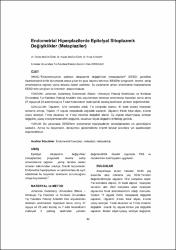| dc.contributor.author | Bozdoğan, Önder | |
| dc.contributor.author | Bozdoğan, Nazan | |
| dc.contributor.author | Atasoy, Pınar | |
| dc.date.accessioned | 2020-06-25T14:41:46Z | |
| dc.date.available | 2020-06-25T14:41:46Z | |
| dc.date.issued | 2001 | |
| dc.identifier.citation | Bozdoğan, Ö., Bozdoğan, N., Atasoy, P. (2001). Endometrial hiperplazilerde epitelyal sitoplazmik değişiklikler (metaplaziler). Çukurova Üniversitesi Tıp Fakültesi Dergisi, 26(2), 92 - 95. | en_US |
| dc.identifier.issn | 0250-5150 | |
| dc.identifier.uri | https://app.trdizin.gov.tr/publication/paper/detail/TVRNMk5EVTE= | |
| dc.identifier.uri | https://hdl.handle.net/20.500.12587/963 | |
| dc.description.abstract | AMAÇ:"Endometriyumun epitelyal sitoplazmik değişiklikleri (metaplaziler)" (EESD) genellikle hiperöstrojenik klinik durumlarda ortaya çıkan bir grup lezyonu tanımlar. EESD'ler prognostik öneme sahip olmamalarına rağmen yanlış tanılara neden olabilirler. Bu çalışmanın amacı endometrial hiperplazilerde EESD'lerin sıklığının ve öneminin araştırılmasıdır. YÖNTEM: Johannes Gutenberg Üniversitesi (Mainz -Almanya) Patoloji Enstitütüsü ve Kırıkkale Üniversitesi Tıp Fakültesi Patoloji Anabilim Dalı arşivlerinden derlenen endometrial hiperplazi tanısı almış 27 olguya ait 23 adet küretaj ve 7 adet histerektomi materyali iki patolog tarafından yeniden değerlendirildi. SONUÇLAR: Olguların, 12'si kompleks atipili, 7'si kompleks atipisiz, 8'i basit atipisiz hiperplazi tanılarını almıştı. Toplam 17 olguda metaplastik değişiklik saptandı. Olguların 8'inde fokal silyalı, 4'ünde yüzey sinsityal, 1'inde skuamoz ve 1'inde müsinöz değişiklik izlendi. Üç olguda silyalıyüzey sinsityal değişiklik, yüzey sinsityaleosinofilik değişiklik, skuamozsilyaiı değişiklik birlikteliği görüldü. YORUM: Bu çalışmada, EESD'lerin endometrial hiperplazilerde beklediğimizden sık görüldüğünü saptadık. Ayrıca bu lezyonların, deneyimsiz gözlemcilerde önemli tanısal sorunlara yol açabileceğini düşünmekteyiz. | en_US |
| dc.description.abstract | PURPOSE: "Endometrial epithelial cytoplasmic changes" (EECC) describe a group of lesions, which are found generally in hyperestrogenic clinical conditions. Although EECC are not important in prognosis, they might cause misdiagnosis. The aim of this study was to investigate the frequency and importance of EECC's in endometrial hyperplasias. METHODS: Twenty three curettage and 7 hysterectomy specimens from 27 cases which were diagnosed as endometrial hyperplasias were collected from the archives of Johannes Gutanberg University (Mainz-Germany) and Kırıkkale University Pathology Departments, and they were reevaluated by two pathologists. RESULTS: Twelve cases were complex hyperplasias with atypia, 7 were complex hyperplasias without atypia and the remaining were simple hyperplasias without atypia. We have observed metaplasia in 17 cases; 8 cases had ciliary metaplasia, 4 had surface syncytial changes,1 had squamous and 1 had mucinous metaplasia. Three cases had associated metaplasias: One had syncytial plus ciliary changes, and each one of the remaining cases had syncytial plus eosinophilic and squamous plus ciliary changes. CONCLUSION: In this study, we determined that EECC are relatively more common morphologic aspects observed in hyperpiasias than we had excepted. We also think that these lesions may cause some important diagnostic problem for the inexperienced observers. | en_US |
| dc.language.iso | tur | en_US |
| dc.rights | info:eu-repo/semantics/openAccess | en_US |
| dc.subject | Cerrahi | en_US |
| dc.title | Endometrial hiperplazilerde epitelyal sitoplazmik değişiklikler (metaplaziler) | en_US |
| dc.title.alternative | Epithelial cytoplasmic changes in endometrial hyperplasias (Metaplasia) | en_US |
| dc.type | other | en_US |
| dc.contributor.department | Kırıkkale Üniversitesi | en_US |
| dc.identifier.volume | 26 | en_US |
| dc.identifier.issue | 2 | en_US |
| dc.identifier.startpage | 92 | en_US |
| dc.identifier.endpage | 95 | en_US |
| dc.relation.journal | Çukurova Üniversitesi Tıp Fakültesi Dergisi | en_US |
| dc.relation.publicationcategory | Diğer | en_US |
















